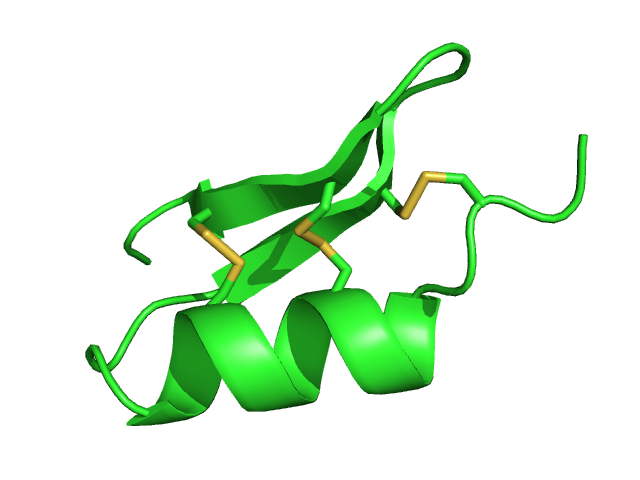scyllatoxin on:
[Wikipedia]
[Google]
[Amazon]
Scyllatoxin (also leiurotoxin I) is a 
toxin
A toxin is a naturally occurring organic poison produced by metabolic activities of living cells or organisms. Toxins occur especially as a protein or conjugated protein. The term toxin was first used by organic chemist Ludwig Brieger (1849– ...
, from the scorpion
Scorpions are predatory arachnids of the order Scorpiones. They have eight legs, and are easily recognized by a pair of grasping pincers and a narrow, segmented tail, often carried in a characteristic forward curve over the back and always end ...
'' Leiurus quinquestriatus hebraeus'', which blocks small-conductance Ca2+-activated K+ channels. It is named after Scylla
In Greek mythology, Scylla), is obsolete. ( ; grc-gre, Σκύλλα, Skúlla, ) is a legendary monster who lives on one side of a narrow channel of water, opposite her counterpart Charybdis. The two sides of the strait are within an arrow's r ...
, a sea monster from Greek mythology
A major branch of classical mythology, Greek mythology is the body of myths originally told by the Ancient Greece, ancient Greeks, and a genre of Ancient Greek folklore. These stories concern the Cosmogony, origin and Cosmology#Metaphysical co ...
. Charybdotoxin
Charybdotoxin (CTX) is a 37 amino acid neurotoxin from the venom of the scorpion '' Leiurus quinquestriatus hebraeus'' (''deathstalker'') that blocks calcium-activated potassium channels. This blockade causes hyperexcitability of the nervous syst ...
is also found in the venom from the same species of scorpion, and is named after the sea monster Charybdis
Charybdis (; grc, Χάρυβδις, Khárybdis, ; la, Charybdis, ) is a sea monster in Greek mythology. She, with the sea monster Scylla, appears as a challenge to epic characters such as Odysseus, Jason, and Aeneas. Scholarship locates her in t ...
. In Greek mythology, Scylla and Charybdis lived on rocks on opposing sides of a narrow strait of water.

Sources
Scyllatoxin is one of the components of thevenom
Venom or zootoxin is a type of toxin produced by an animal that is actively delivered through a wound by means of a bite, sting, or similar action. The toxin is delivered through a specially evolved ''venom apparatus'', such as fangs or a sti ...
of the Israeli scorpion
Scorpions are predatory arachnids of the order Scorpiones. They have eight legs, and are easily recognized by a pair of grasping pincers and a narrow, segmented tail, often carried in a characteristic forward curve over the back and always end ...
''‘Leiurus quinquestriatus hebraeus’''. It consists of only 0.02% of the total protein in crude venom.
Chemistry
Leiurotoxin I is a 31-residue peptide (sequence AFCNLRMCQLSCRSLGLLGKCIGDKCECVKH-NH2), with ahelix
A helix () is a shape like a corkscrew or spiral staircase. It is a type of smooth space curve with tangent lines at a constant angle to a fixed axis. Helices are important in biology, as the DNA molecule is formed as two intertwined helices, ...
and a short antiparallel β-sheet
The beta sheet, (β-sheet) (also β-pleated sheet) is a common motif of the regular protein secondary structure. Beta sheets consist of beta strands (β-strands) connected laterally by at least two or three backbone hydrogen bonds, forming a g ...
. This toxin is stabilized by disulfide bonds
In biochemistry, a disulfide (or disulphide in British English) refers to a functional group with the structure . The linkage is also called an SS-bond or sometimes a disulfide bridge and is usually derived by the coupling of two thiol groups. In ...
: Cys8-Cys26 and Cys12-Cys28 is bound to the β-sheet, while Cys3-Cys21 is bound to an N-terminal segment preceding the helix. Leiurotoxin adopts the ά/β motif. Especially the positively charged residues (Arg6 and Arg13, which are located in the ά helix) are important for the expression of toxin biological activities and for its receptor affinity.
Target
Scyllatoxin is a blocker of small-conductance Ca2+– activated K+ channels at 10−13–10−11 M concentrations in various cell types. This toxin shows similarity in its physiological activity and binding specificity toapamin
Apamin is an 18 amino acid globular peptide neurotoxin found in apitoxin (bee venom). Dry bee venom consists of 2–3% of apamin. Apamin selectively blocks SK channels, a type of Ca2+-activated K+ channel expressed in the central nervous system. ...
, but both toxins show no structural similarity.
Mode of action
Scyllatoxin blocks the slow after- hyperpolarization that follows anaction potential
An action potential occurs when the membrane potential of a specific cell location rapidly rises and falls. This depolarization then causes adjacent locations to similarly depolarize. Action potentials occur in several types of animal cells, ...
in some nerve cells
A neuron, neurone, or nerve cell is an electrically excitable cell that communicates with other cells via specialized connections called synapses. The neuron is the main component of nervous tissue in all animals except sponges and placozoa. No ...
.
Toxicity
Scyllatoxin induces spontaneous contractions inguinea pig
The guinea pig or domestic guinea pig (''Cavia porcellus''), also known as the cavy or domestic cavy (), is a species of rodent belonging to the genus ''Cavia'' in the family Caviidae. Breeders tend to use the word ''cavy'' to describe the ani ...
taenia coli muscle cells that have
been relaxed with epinephrine.
References
{{Toxins Neurotoxins Ion channel toxins Scorpion toxins